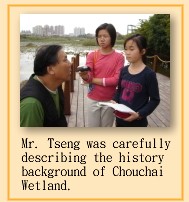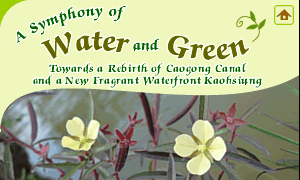 |
A Volunteer Worker at Chouchai Wetland
Mr.
Ching-Chia Tseng
¡»Date: 9th. Feb, 2007 (Fri.)
¡»Location: Chouchai Wetland
¡»Interviewers: Bo-Qian Wu, Jia-Wen Wu, Yu-Rou Li |
|
Mr. Ching-Chia Tseng, a long-term volunteer worker at Chouchai Wetland, has witnessed the birth and development of Chouchai Wetland. He is wedded to this job. In our several visits to Chouchai Wetland, he had been always full of passion to help us. As being unable to turn down our requests, he finally accepted for interview:
|
Q¡GHow long have you been working at Chouchai Wetland? |
A¡GI started in August 2003. I didn't know about Chouchai Wetland in Tzo-Ying until I read about it in the media. Why I decided to come here? Although I currently do not live in Tzo-Ying, my ancestors settled down here about 200 or 300 years ago, and it's the place where I was born and grown up. When I read an article about a park going to be built at Chouchai Wetland, I decided to join the project. |
Q¡GWhy do you want to work here? |
A¡GAs mentioned, my home town is Tzo-Ying but I rarely spend time here. Whenever I returned back here, my childhood memory flashed back. It is truly a beautiful place. Although this place has been changed, Chouchai Wetland is still a hard-to-found demonstrated wetland in a city. Often people ask me why I came here to work, my first response is that here is like my home backyard and I want to devote myself here. Of course, this may sound selfish as taking here as my home but this is an immediate response without thinking. After all, I work here because I love my home town, Tzo-Ying. |
Q¡GYou mentioned that the environment is different from the one you had in childhood. What's the difference? |
A¡GThere are a lot of differences. We now can see there are many tall buildings spreading out on the east while there was nothing before and easy to see the far end. My home was in Tzo-Ying Old Gate on the west side of Lotus Pond. I was even able to see the big commercial plate of "Xiao-Mei Ice Cream" on Ming-Zu Road because there was no tall building around. As for now, the view is totally blocked by buildings. That is a huge difference.
To have a park of wetland nature in a city is not easy. Whenever I work here, I always think about my childhood. Once Wetlands Taiwan Organization issued a special magazine about Chouchai Wetland, in which several articles written by volunteer workers were included. My article is named "I am cheered now!" In my childhood, I was told not to play in Lotus Pond by my mother while all other kids could. I was very jealous of my neighbors as they looked so happy at playing with water; especially our house was just next to Lotus Pond. It is true that the water of Lotus Pond was clear and clean enough for swimming. And now I come to work at Chouchai Wetland, and the first task is to go into water to work, which does cheer me up. |
Q¡GBefore Chouchai Wetland was built, how did this place look like? |
A¡G There were fields all over, paddy fields mostly, behind the current entrance. The only way out of Chouchai Wetland is this old walkway on the north east, which is also the only path to go out from Chouchai Village. In Lotus Pond, there were full of water chestnut fields. As for why is it called Lotus Pond? Honestly, I don't know. In my memory, it seems I have never seen any lotus in Lotus Pond before as water chestnuts occupied most of it. |
Q¡GWhat and how is the process of building up Chouchai Wetland? |
A¡GChouchai Wetland was preserved as Tzo-Ying park #1. The government of old mayor Nan-Cheng Su acquired this land for a traditional art park. When it came to the government of mayor Den-Yih Wu, this plan was still not being carried out. Later, the plan was cancelled and modified into a preserved land for a general park. Later, the government of mayor Chang-Ting Hsieh arrived. In 2002, it was the year of deadline. If no park was going to be built here before the deadline past, the land should be returned to farmers. Soon, the project of Chouchai Wetland launched.
On the other hand, Taiwan High Speed Rail, right on our east side, was about to open, and the city government had to make sure its neighborhood was ready, too. When the project news of building a park here was out in 2002, it attracted interests from several southern green organizations, including Kaohsiung Wild Bird Society, Jiu-Cheng Culture Society, Wetlands Taiwan Organization, etc. They commented that it would be a pity if a park like this, as big as 4 hectares, is only a general one. The green organizations proposed to the city government to build an ecological nature park. As a result, Wetlands Taiwan Organization took the lead and addressed the project of "Jacanas Return". But, do you know why?
It has to go back to year 1860. The deputy consul of the British Consulate at Takao was a biologist and discovered jacanas in Kaohsiung. Surely jacanas were here since the beginning, however as the deputy consul recorded this down, it became the earliest documentary of jacanas. The fact was that jacanas like floating-leaved water plants, plus water chestnuts occupied most of this place, therefore jacanas liked to spend time and stay on the leaves of water chestnuts. With their long feet and nails, they wouldn't sink into the water. They couldn't swim but they could balance themselves on the leaves well. Unfortunately, in 1980s, some water chestnut fields and wetlands were filled up for residential buildings, which destroyed the habitat of jacanas. Since then, jacanas disappeared from the greater Kaohsiung area. Therefore, Wetlands Taiwan Organization started from this point and proposed to customize an ecological park for jacanas which was later being approved by Kaohsiung City Government. The park also requires professionals to perform management and maintenance duty after being built. Hence Wetlands Taiwan Organization accepts the duty.
At the end of 2002, the project finally launched. The first phase of construction was to dig a pond larger than 4 hectares and confined the park in early 2003. By May in the same year, Wetlands Taiwan Organization signed an official contract with the government and agreed to adopt Chouchai Wetland free while no subsidy would be provided. In the first year, Wetlands Taiwan Organization had to collect donations and recruit volunteer works to run this place.
Wetlands Taiwan Organization was not sponsored by any private group and had to collect funds to operate Chouchai Wetland. They applied for Ford Conservation & Environmental Grants and being rewarded as the winner with one million dollars, which solved the first urgent problem in 2003.
The second phase of construction started in 2004 was to dig two medium- to small-sized ponds and to organize gardens for baby butterflies. At the end of 2005, the third phase of construction was completed which emphasized on the management of the south side and the scenic spot. In the first phase, the deepest part of pond was less than 1m and easy to silt up, generating various water plants. Differed from the first and second phases, the third phase was to build up a favored environment for anatidae birds with a deeper water pond, around 3m. And, just recently, there is another construction called "Fragrant River Banks" which is to rebuild the pathway from the main entrance by planting lots of tall green plants. As for the future, we have proposed to the government of planning a Nature Observation Center where the public can observe animals without disturbing them.
Finally, here is a park but it's very close to Taiwan High Speed Rail, and we are not sure if the government will turn the land to a residential zone one day. Certainly, we wish all citizens can enjoy and like this wetland. Gather everyone's consensus and recognition is the most important thing. |
Q¡GDo you know the project of ecological wetland corridor? |
The plan of ecological corridor covers from the Yuanjhong Port Wetland in Kaohsiung, via Banping Lake Wetland in Bamping mountain, Chouchai Wetland and Neiweipei Wetland in Museum of Fine Art, to Love River. Those places are getting ready one after another.
Yuanjhong Port Wetland is focusing on protecting mangroves. It used to be an U.S. army base before renting to fishermen. Fishermen used the place as fish farms which brought in water to keep mangroves alive as they were. When the place was turned to a park and considered to remove those mangroves, green organizations came and warned those mangroves would die once removed. Consequently, the 30-hectare land turns out to be current Yuanjhong Port Wetland.
There are walkways in Banping Lake Wetland. In fact, Banping Lake Wetland cannot supply itself water demand for the whole year so it has to rely on rains as the water source. Besides, its landscape cannot store water as limestone leaks water out. Also, because there were sands flowing down when cement plants are doing the mining, there is a basin built to deposit sinking sand. Now, there is no more mining in Bamping mountain, but it was over mined before, hence whenever the rain water reaches 2-3m height, the water was turned into beautiful turquoise color.
As for Love River, it used to be so stinky that no one dares to get close to it. Now, Jhongdu Love River Wetland is created by ecological techniques and replaces concrete surface of dikes. Even the area of "broken dike" is not very long but the ecology is much richer than ever before. I heard there are even jellyfishes living in Love River now! |
Q¡GWhat do you think of working here? What are your feelings? |
A¡GThere used to be only two volunteer workers here, me and CEO. If I didn't come here for a day, I felt there was something missing in my heart. Each time I came here, I got happier to see it's getting prettier and nicer. Now, all volunteer workers are like a big family, sharing the same consensus and getting along very well. We don't get paid but we are all working happily. |
Q¡GHow many volunteer workers are working here? |
A¡GThere are actually quite a big number of registered volunteer workers but only around 10 people really show up. Some are working at fixed times while some work for a short time of period. |
Reflection

From Mr. Zeng, we can feel his passion for his dream. He transforms his love of home town to real actions and dedicates his time and energy. We believe there are many people like Mr. Zeng love their home towns in their own ways. Expect ourselves to learn from Mr. Zeng and his commitment spirit, returning his home town with heart. |
|
|

